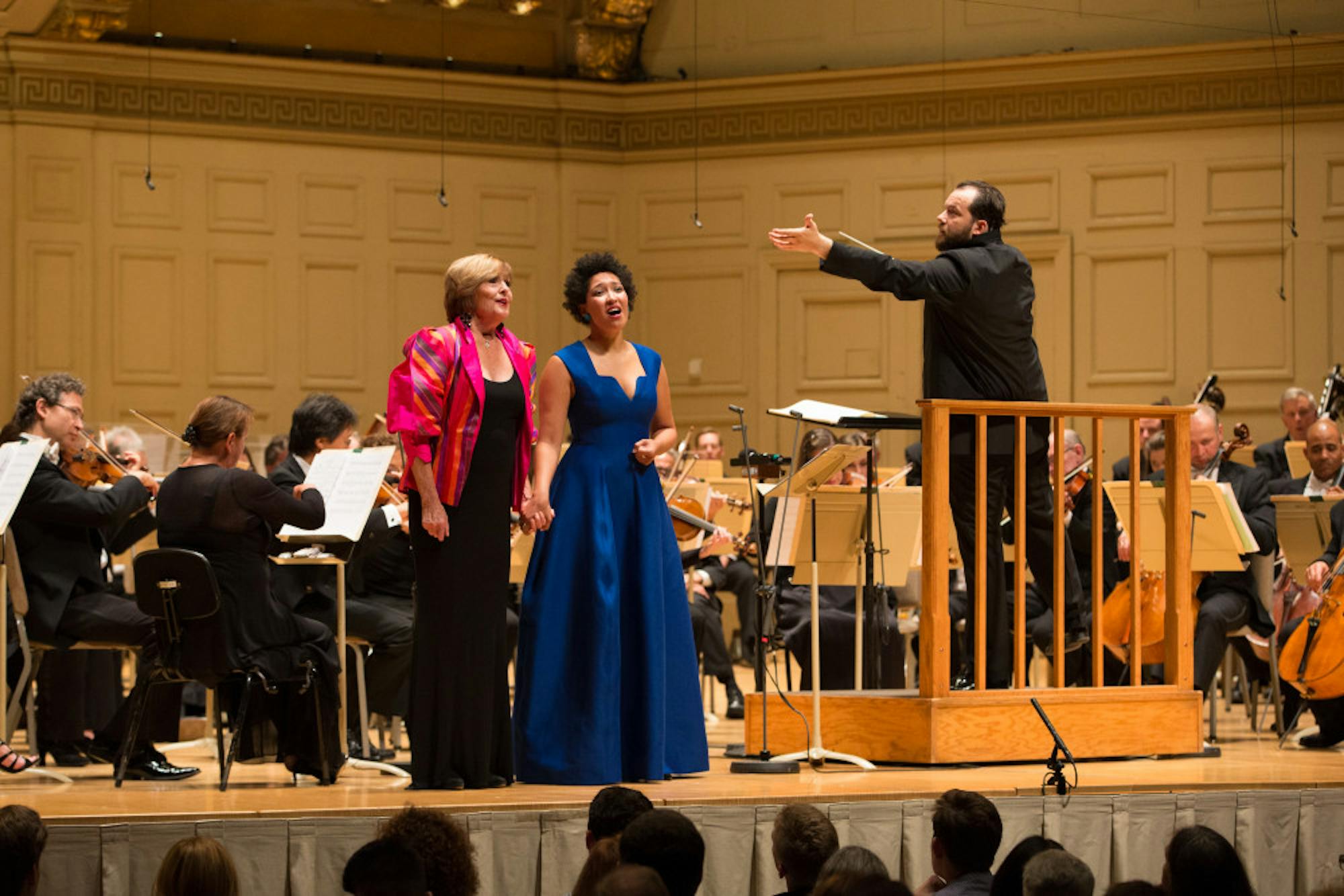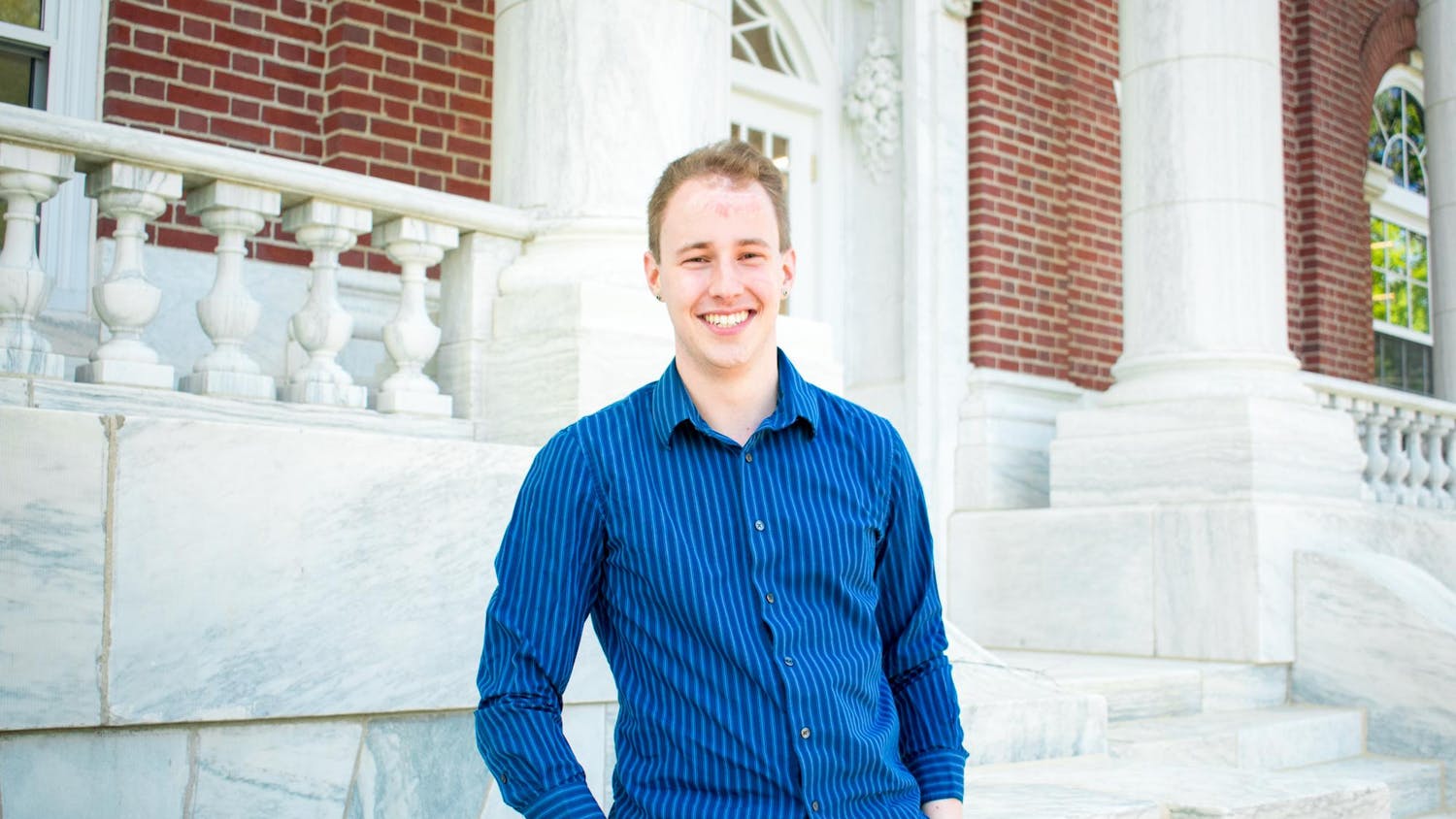Last Friday night, the Boston Symphony Orchestra (BSO), led by conductor Andris Nelsons, kicked off its new season at Symphony Hall with a program centered on the centennial of celebrated composer and Boston-area native Leonard Bernstein.
At most classical orchestral concerts, the orchestra and music stand alone in the spotlight. At this event, however, the BSO celebrated Bernstein’s life and music: his legacy winked at every turn in Symphony Hall.
During the pre-concert reception for all ticket holders, a gradient of purple and yellow light bathed the O’Block-Kay Room and projected whimsical floral designs on the ceiling. Although the BSO encourages the audience to don formal attire, there was a distinct range in formality, from a bun-topped young man clad in sweats and wearing sneakers to an older patron sporting a tuxedo and cummerbund, red rose pinned to his lapel. Concertgoers strolled through the hallways, clutching wineglasses and reading exhibits on Bernstein’s life and career that focused on his Boston and BSO roots.
A surprising layer to the evening’s entertainment were the dancers positioned on staircases and in the hallways, courtesy of ToUch Events and inspired by Bernstein’s musical “West Side Story" (1957). Reflecting “individual phrases” of music, the dancers’ movements gradually built in expression and scale through the post-concert dinner until dessert, when the male and female dancers joined in lifts, jumps and turns. Marissa Roberts, co-founder of ToUch Events, said that ToUch Events and the BSO’s artistic vision was to create “something classical yet modern, something that would stand out from the guests but also blend in.”
A little past 6 p.m., the all-Bernstein program commenced with a literal bang in the first movement of his Divertimento for Orchestra (1980) — an accented percussion hit followed by a rapid triplet explosion from the trumpet section. According to the program notes, the eight-movement suite (dedicated to the BSO almost four decades ago) is harmonically centered on the musical notes B and C, B for Boston and C for Centennial. The music doesn’t always take itself seriously; the bumbling Turkey Trot theme voiced by the clarinet has no pretensions of being high classical music. Still, the Divertimento has the advantage of highlighting every section of the orchestra, and in a group of the BSO’s caliber where there are virtually no weak links, the listening experience left little to desire.
Next, principal flutist Elizabeth Rowefilled Symphony Hall with the somber and contemplative “Halil” (1981) for flute and orchestra. “Halil” means “flute” in Hebrew, and was inspired by a 19-year-old Israeli flutist who was killed in the Yom Kippur War of 1973. The composer described it as “an ongoing conflict of nocturnal images” that manifests itself in the friction between the tonal and non-tonal, a musical conceit for the opposing forces that create violence in the real world. Rowe’s flute cadenza sounded appropriately disillusioned, although the piece ends on a hopeful note.
Soprano Julia Bullock and mezzo-soprano Frederica von Stade masterfully carried the program’s mix of classical and Broadway vocal selections by Bernstein with elegance and superb technical support. Bullock, making her BSO debut, shined especially singing “It Must Be So” from “Candide” (1956); her voice shimmered like the cool, luminescent surface of a body of water at night. Members of the Tanglewood Festival Chorus, wearing boas and playful hats, provided a comical backdrop for von Stade’s rich and robust rendition of “I am Easily Assimilated,”also from “Candide.”
The "Symphonic Dances from West Side Story” (1960), an orchestral medley of the musical’s most memorable songs, provided a satisfying culmination to the evening’s musical offerings. The score and choreography of the musical pay their respects to traditional forms while welcoming modern ideas, and the music’s lasting notoriety in American culture speaks to Bernstein’s success at not only executing but marrying classical, musical theater and jazz styles. Thus, beyond being an obvious crowd-pleaser, “West Side Story” is highly representative of Bernstein’s musical essence, making it an appropriate selection for the concert’s program closer.
The BSO’s final notes were met with a hearty standing ovation from the packed hall. As concertgoers filed down the hallway into the foyer, staff members handed out cards featuring photos of Bernstein on the front and facts about his music career on the back. A female dancer in a purple top and blue skirt rose to a relevé and looked wistfully into the distance, presumably searching for the Tony to her Maria.
The standard of musical and thematic execution exhibited by the BSO on Friday sets a high bar for the orchestra as they head into the 2017–2018 season. With old gems like Stravinsky’s “The Firebird” (1910) and Rachmaninoff’s "Symphony No. 2" (1908) on the docket alongside contemporary works and a world premiere, it is clear that the orchestra has enthusiastically embraced the versatile essence of Bernstein’s musical legacy.
Boston Symphony Orchestra opens 2017–2018 season with inspired Bernstein tribute

BSO Music Director Andris Nelsons leads Julia Bullock and Frederica Von Stade on Opening Night.





